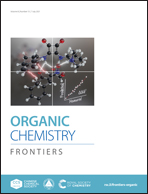Iron- and zinc-mediated reductive coupling of styrenes and alkyl bromides: mechanistic investigation using DFT calculations†
Abstract
An efficient and practical method for the reductive coupling of 4-t-butylstyrene and (3-bromopropoxy)benzene in the presence of Fe(NH4)2(SO4)2 and Zn in an aqueous micellar medium was developed. Density functional theory calculations were used to identify the possible catalytic mechanisms and the origin of the regioselectivity in this conversion. The theoretical results indicate that the reaction barriers are high when iron or zinc is used alone. However, a combination of iron and zinc considerably lowers the reaction barriers. These findings are consistent with experimental observations that no product was formed in the presence of either metal alone. The results show that the catalytic cycle involves initial Fe(I)-mediated alkyl radical formation, bromide migration to Zn, radical coordination to Fe, a Zn-assisted switch from the η2 mode to the η1 mode for iron binding to the carbonyl group, Fe-mediated C–C bond formation between the alkyl radical and 4-t-butylstyrene, and protonation of the α carbon of 4-t-butylstyrene. The origin of the preferred regioselectivity, i.e., C–C coupling with the β carbon rather than the α carbon of 4-t-butylstyrene, is attributed to a lower distortion energy.



 Please wait while we load your content...
Please wait while we load your content...